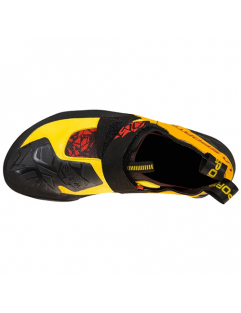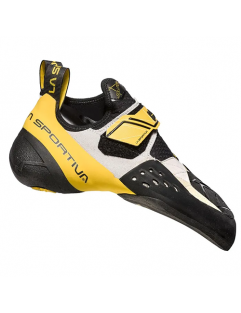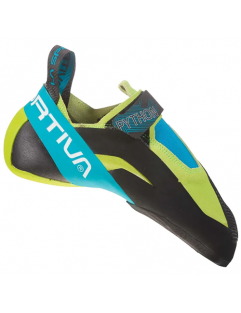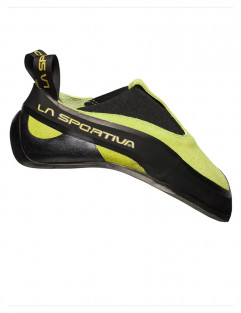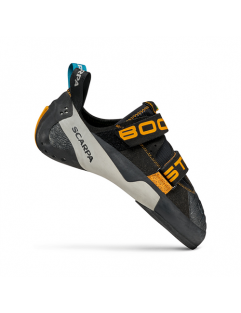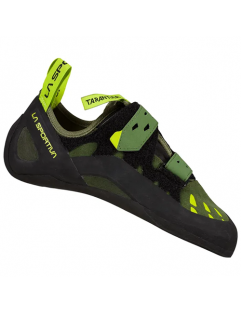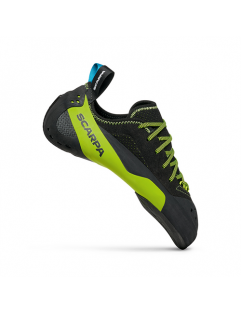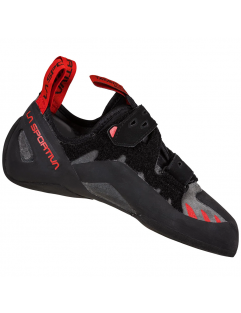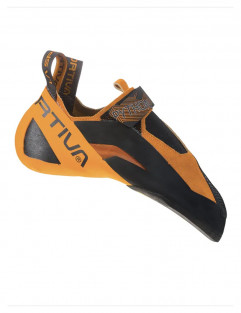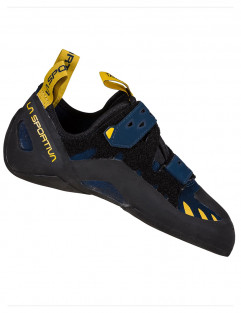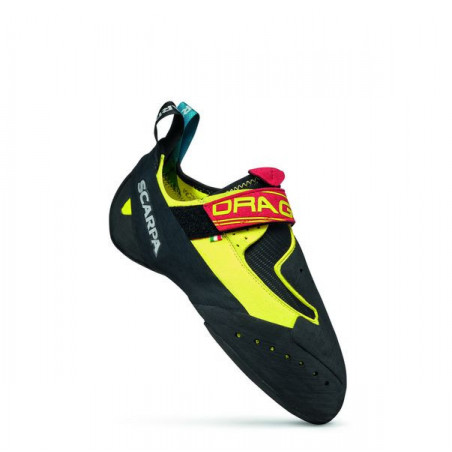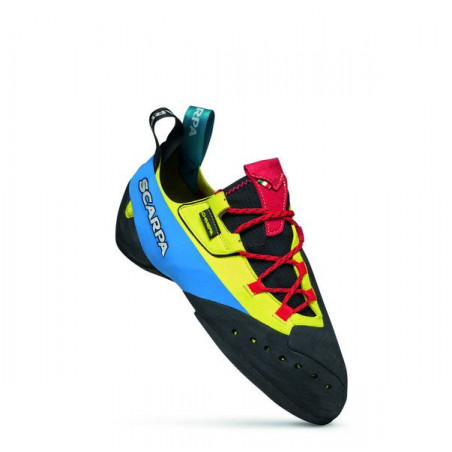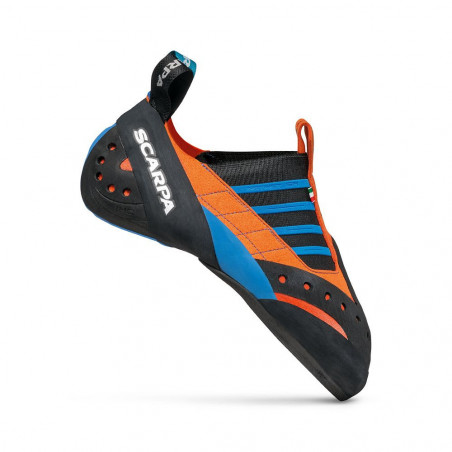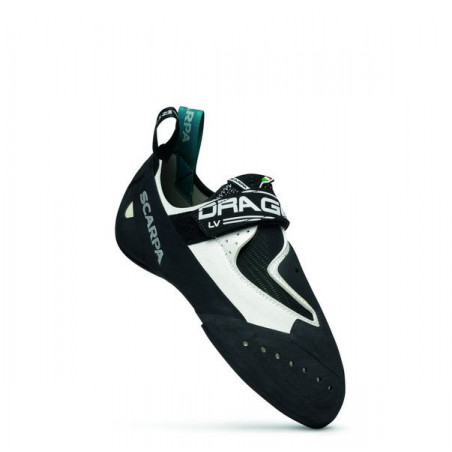New products
home
Arc'teryx -...Active filters
velcro-shoes
La Sportiva - Skwama - Black/Yellow - Climbing Shoesvelcro-shoes
La Sportiva - Solution - White /Yellow - Men's Climbing...slippers
La Sportiva - Cobra - Apple Green - Climbing Shoesvelcro-shoes
Scarpa - Booster - Black/Orange - Climbing Shoesvelcro-shoes
La Sportiva - Tarantula - Olive/Neon - Climbing Shoeslace-up-shoes
Scarpa - Mago - Black/Green - Climbing Shoesvelcro-shoes
La Sportiva - Tarantula Boulder - Metal/Sunset - Men's...velcro-shoes
La Sportiva - Tarantula Boulder - Night Blue/Moss - Men's...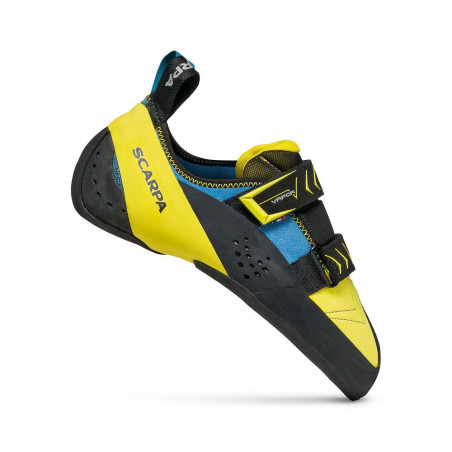
Mens Climbing Shoes
The climbing shoes on the market now a days make it possible for athletes to almost walk up the wall and to stand on seemingly smooth surfaces and none existing foot holds. This has all been made possible through years of research, trial and error. The rubber used for the soles of climbing shoes generates as much friction as possible in order for the athlete to perform at peak levels. Most, if not all intermediate to advanced climbing shoes are equipped with these high performance soles, but there are still a few differences worth pointing out.



When it comes to choosing your climbing / bouldering shoes there are two main criteria to look out for, comfort and functionality.These two are not correlated, meaning that if you want your shoe to be a bit more comfortable and less tight, you will most likely pay the price in functionality and the other way around. Furthermore, climbing shoes will expand with use and wear, especially the leather shoes can change their shape and size quiet a bit, which is why, if you want performance, it makes sense to initially buy these pairs pretty tight. Synthetic shoes on the other hand will not loosen as much. This covers the aspect of comfort, optimised functionality is usually achieved as long as the shoe is snug fitting around the heel and as long as the big toe touches the tip of the toe cap. Anything else, like shape, material, closing system etc has it's advantages and disadvantages and is up to the climbers preferences and climbing needs.
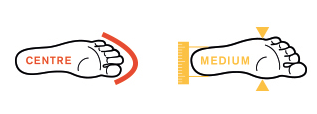
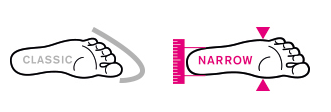

Many climbing shoes come in a unisex/men's version and a women-specific version. As with any shoe, the biggest differences between men's and women's climbing shoes are volume and width. Women-specific shoes typically have a lower volume, a smaller toe box, and a narrower heel.
The choices are endless and difficult today so contact our Customer Service or send us a mail to help you choose the right product for your needs.
Shop online.........more time to climb.
Casper's Supports Your Summit
Subcategories
-
Velcro Shoes
<p>In climbing most things are pretty clear, a route/boulder has its grade and every piece of gear has it's job, so why is there always this confusion around velcro vs lace shoes. To generalise this discussion lets compare lace to any other shoe, be it velcro, slipper or what they call low volume. </p> <p>Ultimately the choice comes down to personal preference, but there are a few aspects to consider when purchasing a climbing shoe and it all has to do with what kind of climbing you are planning to do. If you are a gym rat spending most of their time climbing/bouldering on plastic you will probably prefer the convenience of velcro and slip on shoes. For this type of climbing, people tend to wear quiet aggressive shoes, forcing their feet in weird positions to maximise precision/performance whilst sacrificing comfort. Another reason to wear your shoes super tight is when you are working a project. The extra tightness can provide the necessary precision to complete the problem and being able to quickly take your shoes off is a big advantage. Furthermore, especially whilst bouldering, a lot of time is spend standing and waiting between climbs, that is when you want to slip in something comfy and take those climbing shoes off quickly. </p> <p>With climbing styles that require longer time spent on the rock such as multi pitching or traditional climbing comfort is more important than performance which is why climbers tend towards lace up shoes. These allow for micro adjustments, loosening and tightening in different areas which is a huge advantage. </p> <p>Moreover, if you have a super weird shaped foot lace climbing shoes will probably give you a better fit than velcors due to the previously mentioned ability to perform micro adjustments when tightening them. </p> <p>Now let's talk maintenance. I've heard and said it over again, lace shoes are not great for toe hooking because we tend to tear the laces off, especially with high level bouldering. Fortunately, laces are easy to replace, which cannot be said about velcro. Velcro might not tear as quickly as laces do but once those velcro teeth collect some dirt they quickly lose effectiveness. </p> <p>In conclusion, the main benefit of velcro shoes is the ease with which you can get them on and off, which is also the main reason most gyms will rent velcro shoes and most climbers in the gym are wearing velcro. The downside... you do not have that much control over the fit. </p> <p></p> <p> The choices are endless and difficult today so contact our Customer Service or send us a mail to help you choose the right product for your needs. </p> <p></p> <p>Shop online.........more time to climb.</p> <p></p> <p>Casper's Supports Your Summit</p> <p></p> -
Lace-Up Shoes
<p>In climbing most things are pretty clear, a route/boulder has its grade and every piece of gear has it's job, so why is there always this confusion around velcro vs lace shoes. To generalise this discussion lets compare lace to any other shoe, be it velcro, slipper or what they call low volume. </p> <p>Ultimately the choice comes down to personal preference, but there are a few aspects to consider when purchasing a climbing shoe and it all has to do with what kind of climbing you are planning to do. If you are a gym rat spending most of their time climbing/bouldering on plastic you will probably prefer the convenience of velcro and slip on shoes. For this type of climbing, people tend to wear quiet aggressive shoes, forcing their feet in weird positions to maximise precision/performance whilst sacrificing comfort. Another reason to wear your shoes super tight is when you are working a project. The extra tightness can provide the necessary precision to complete the problem and being able to quickly take your shoes off is a big advantage. Furthermore, especially whilst bouldering, a lot of time is spend standing and waiting between climbs, that is when you want to slip in something comfy and take those climbing shoes off quickly. </p> <p>With climbing styles that require longer time spent on the rock such as multi pitching or traditional climbing comfort is more important than performance which is why climbers tend towards lace up shoes. These allow for micro adjustments, loosening and tightening in different areas which is a huge advantage. </p> <p>Moreover, if you have a super weird shaped foot lace climbing shoes will probably give you a better fit than velcors due to the previously mentioned ability to perform micro adjustments when tightening them. </p> <p>Now let's talk maintenance. I've heard and said it over again, lace shoes are not great for toe hooking because we tend to tear the laces off, especially with high level bouldering. Fortunately, laces are easy to replace, which cannot be said about velcro. Velcro might not tear as quickly as laces do but once those velcro teeth collect some dirt they quickly lose effectiveness. </p> <p>In conclusion, the main benefit of velcro shoes is the ease with which you can get them on and off, which is also the main reason most gyms will rent velcro shoes and most climbers in the gym are wearing velcro. The downside... you do not have that much control over the fit. </p> <p></p> <p> The choices are endless and difficult today so contact our Customer Service or send us a mail to help you choose the right product for your needs. </p> <p></p> <p>Shop online.........more time to climb.</p> <p></p> <p>Casper's Supports Your Summit</p> <p></p> -
Slippers
<p>In climbing most things are pretty clear, a route/boulder has its grade and every piece of gear has it's job, so why is there always this confusion around velcro vs lace shoes. To generalise this discussion lets compare lace to any other shoe, be it velcro, slipper or what they call low volume. </p> <p>Ultimately the choice comes down to personal preference, but there are a few aspects to consider when purchasing a climbing shoe and it all has to do with what kind of climbing you are planning to do. If you are a gym rat spending most of their time climbing/bouldering on plastic you will probably prefer the convenience of velcro and slip on shoes. For this type of climbing, people tend to wear quiet aggressive shoes, forcing their feet in weird positions to maximise precision/performance whilst sacrificing comfort. Another reason to wear your shoes super tight is when you are working a project. The extra tightness can provide the necessary precision to complete the problem and being able to quickly take your shoes off is a big advantage. Furthermore, especially whilst bouldering, a lot of time is spend standing and waiting between climbs, that is when you want to slip in something comfy and take those climbing shoes off quickly. </p> <p>With climbing styles that require longer time spent on the rock such as multi pitching or traditional climbing comfort is more important than performance which is why climbers tend towards lace up shoes. These allow for micro adjustments, loosening and tightening in different areas which is a huge advantage. </p> <p>Moreover, if you have a super weird shaped foot lace climbing shoes will probably give you a better fit than velcors due to the previously mentioned ability to perform micro adjustments when tightening them. </p> <p>Now let's talk maintenance. I've heard and said it over again, lace shoes are not great for toe hooking because we tend to tear the laces off, especially with high level bouldering. Fortunately, laces are easy to replace, which cannot be said about velcro. Velcro might not tear as quickly as laces do but once those velcro teeth collect some dirt they quickly lose effectiveness. </p> <p>In conclusion, the main benefit of velcro shoes is the ease with which you can get them on and off, which is also the main reason most gyms will rent velcro shoes and most climbers in the gym are wearing velcro. The downside... you do not have that much control over the fit. </p> <p></p> <p> The choices are endless and difficult today so contact our Customer Service or send us a mail to help you choose the right product for your needs. </p> <p></p> <p>Shop online.........more time to climb.</p> <p></p> <p>Casper's Supports Your Summit</p> <p></p> -
Low Volumes Shoes
<p>In climbing most things are pretty clear, a route/boulder has its grade and every piece of gear has it's job, so why is there always this confusion around velcro vs lace shoes. To generalise this discussion lets compare lace to any other shoe, be it velcro, slipper or what they call <strong>low volume</strong>. </p> <p>Ultimately the choice comes down to personal preference, but there are a few aspects to consider when purchasing a climbing shoe and it all has to do with what kind of climbing you are planning to do. If you are a gym rat spending most of their time climbing/bouldering on plastic you will probably prefer the convenience of velcro and slip on shoes. For this type of climbing, people tend to wear quiet aggressive shoes, forcing their feet in weird positions to maximise precision/performance whilst sacrificing comfort. Another reason to wear your shoes super tight is when you are working a project. The extra tightness can provide the necessary precision to complete the problem and being able to quickly take your shoes off is a big advantage. Furthermore, especially whilst bouldering, a lot of time is spend standing and waiting between climbs, that is when you want to slip in something comfy and take those climbing shoes off quickly. </p> <p>With climbing styles that require longer time spent on the rock such as multi pitching or traditional climbing comfort is more important than performance which is why climbers tend towards lace up shoes. These allow for micro adjustments, loosening and tightening in different areas which is a huge advantage. </p> <p>Moreover, if you have a super weird shaped foot lace climbing shoes will probably give you a better fit than velcors due to the previously mentioned ability to perform micro adjustments when tightening them. </p> <p>Now let's talk maintenance. I've heard and said it over again, lace shoes are not great for toe hooking because we tend to tear the laces off, especially with high level bouldering. Fortunately, laces are easy to replace, which cannot be said about velcro. Velcro might not tear as quickly as laces do but once those velcro teeth collect some dirt they quickly lose effectiveness. </p> <p>In conclusion, the main benefit of velcro shoes is the ease with which you can get them on and off, which is also the main reason most gyms will rent velcro shoes and most climbers in the gym are wearing velcro. The downside... you do not have that much control over the fit. </p> <p>Now let's introduce the low volume concept. Couple of years back they were still called <em>womens shoes </em>but since a lot of men tend to squeeze their feet in them too, brands have decided to call these designs low volume (LV). Essentially the shoes are the same except for the slightly narrower shape around the foot arch and less volume on top of the shoe. </p> <p><img src="https://www.caspersclimbingshop.com/img/cms/scarpa_0023_70017-000-1_dra_yel_drago_yellow.jpeg" alt="normal design" width="280" height="280" /><img src="https://www.caspersclimbingshop.com/img/cms/scarpa-drago-lv-unisex-climbing-shoe.jpg" alt="" width="280" height="299" /></p> <p>Drago vs Drago LV</p> <p></p> <p> The choices are endless and difficult today so contact our Customer Service or send us a mail to help you choose the right product for your needs. </p> <p></p> <p>Shop online.........more time to climb.</p> <p></p> <p>Casper's Supports Your Summit</p> <p></p>






